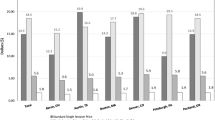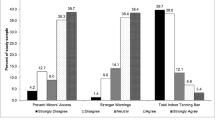Abstract
Adolescents frequenting indoor tanning facilities may have an increased risk of skin cancer. The high level of indoor tanning by this age group may be due, in part, to the large number of tanning facilities in US cities. This study examined how facilities are distributed throughout one large county. Based on ecological models, it was predicted that tanning facilities are more likely to be located within certain neighborhoods based on the neighborhood’s distributions of demographic factors, including income, educational attainment, race/ethnicity, age, and sex. We also explored whether selected aspects of the built environment, including the numbers of high schools and fitness centers, would predict the number of tanning facilities. The number of tanning facilities within 605 census tracts of San Diego County was examined through geographic information systems mapping. Results from multivariate Poisson log-linear regression indicated that higher numbers or proportions of the following variables within a census tract were significantly, positively correlated with the number of tanning facilities: fitness centers, teenagers 15–19 years, females 15–24 years, females 25–29 years, and non-Hispanic Whites. Results from additional analyses using a 1000-foot buffer zone around each census tract boundary showed that higher relative distributions of the following variables were significantly, positively correlated with the number of tanning facilities: high schools, fitness centers, females 15–24 years, females 25–29 years, and non-Hispanic Whites. These findings suggest a relationship exists between the numbers of tanning facilities and certain built-environmental and demographic characteristics within census tracts. Determining this relationship is important for developing future interventions.
Similar content being viewed by others
References
American Cancer Society. (2006). Cancer facts and figures 2006. Atlanta, GA: American Cancer Society.
Lewis, K. G., & Weinstock, M. A. (2004). Nonmelanoma skin cancer mortality (1988–2000): The Rhode Island follow-back study. Archives of Dermatology, 140, 837–842.
Gallagher, R. P., Spinelli, J. J., & Lee, T. K. (2005). Tanning beds, sunlamps, and risk of cutaneous malignant melanoma. Cancer Epidemiology, Biomarkers & Prevention, 14, 562–566.
Karagas, M. R., Stannard, V. A., Mott, L. A., Slattery, M. J., Spencer, S. K., & Weinstock, M. A. (2002). Use of tanning devices and risk of basal cell and squamous cell skin cancers. Journal of the National Cancer Institute, 94, 224–226.
Swerdlow, A. J., & Weinstock, M. A. (1998). Do tanning lamps cause melanoma? An epidemiologic assessment. Journal of the American Academy of Dermatology, 38, 89–98.
Veierod, M. B., Weiderpass, E., Thorn, M., Hansson, J., Lund, E., & Armstrong, B. et al. (2003). A prospective study of pigmentation, sun exposure, and risk of cutaneous malignant melanoma in women. Journal of the National Cancer Institute, 95, 1530–1538.
Indoor Tanning Association. (2005). About the indoor tanning industry [Online]. Available from: http://www.theita.com/indoor/faq.cfm [cited 2005 Feb 12].
Lookingfit.com. (2004). Tanning fact book 2004/2005. Phoenix, AZ: Virgo Publishing.
Cokkinides, V. E., Weinstock, M. A., O’Connell, M. C., & Thun, M. J. (2002). Use of indoor tanning sunlamps by US youth, ages 11–18 years, and by their parent or guardian caregivers: Prevalence and correlates. Pediatrics, 109, 1124–1130.
Demko, C. A., Borawski, E. A., Debanne, S. M., Cooper, K. D., & Strange, K. C. (2003). Use of indoor tanning facilities by white adolescents in the United States. Archives of Pediatrics & Adolescent Medicine, 157, 854–860.
Geller, A. C., Colditz, G., Oliveria, S., Emmons, K., Jorgensen, C., & Aweh, G. N. et al. (2002). Use of sunscreen, sunburning rates, and tanning bed use among more than 10 000 US children and adolescents. Pediatrics, 109, 1009–1014.
Lazovich, D., & Forster, J. (2005). Indoor tanning by adolescents: prevalence, practices and policies. European Journal of Cancer, 41, 20–27.
McLeroy, K. R., Bibeau, D., Steckler, A., & Glanz, K. (1988). An ecological perspective on health promotion programs. Health Education Quarterly, 15, 351–377.
Sallis, J. F., & Owen, N. (2002). Ecological models of health behavior. In K. Glanz, R. Rimer, & F. Lewis (Eds.), Health Behavior and Health Education: Theory, Research, and Practice (3rd ed., pp. 462–484). San Francisco: Jossey-Bass.
Palmer, R. C., Mayer, J. A., Woodruff, S. I., Eckhardt, L., & Sallis, J. F. (2002). Indoor tanning facility density in eighty US cities. Journal of Community Health, 27, 191–202.
Higgs, G., & White, S. (1997). Changes in service provisions in rural areas. Part 1: The use of GIS in analysing accessibility to services in rural deprivation research. Journal of Rural Studies, 13, 441–450.
US Census Bureau (2007). American factfinder dicennial census 2000 summary files [Online]. Available from: http://factfinder.census.gov/servlet/DatasetMainPageServlet?_program=DEC&_submenuld=&_lang=en&_ts= [cited 2007 Feb 21].
Edvardsen, L. (2005). Spring ahead with spring specials. Tanning Trends, 99–102.
San Diego Association of Governments. SANDAG GIS digital boundary files & layers: Land cover and activity centers: School sites [Online]. Available from: http://www.sandag.org/resources/maps_adn_gis/gis_downloads/land.asp. [cited 2007 Feb 20].
Pucci, L. G., Joseph, H. M. Jr., & Siegel, M. (1998). Outdoor tobacco advertising in six Boston neighborhoods. Evaluating youth exposure. American Journal of Preventive Medicine, 15, 155–159.
Autier, P., Dore, J. F., Lejeune, F., Liénard, D., André, J., & Achten, G. (1994). Cutaneous malignant melanoma and exposure to sunlamps or sunbeds: An EORTC multicenter case-control study in Belgium, France and Germany. International Journal of Cancer, 58, 809–813.
Oliphant, J. A., Forster, J. L., & McBride, C. M. (1994). The use of commercial tanning facilities by suburban Minnesota adolescents. American Journal of Public Health, 84, 476–478.
Stryker, J. E., Lazovich, D., Forster, J. L., Emmons, K. M., Sorensen, G., & Demierre M. (2004). Maternal/female caregiver influences on adolescent indoor tanning. Journal of Adolescent Health, 35, 528 e1–528 e9.
Acknowledgements
Supported by grants #R01CA93532 and K05CA10051 from the National Institutes of Health, National Cancer Institute. We thank Ms. Debra Rubio for preparing the manuscript.
Author information
Authors and Affiliations
Corresponding author
Rights and permissions
About this article
Cite this article
Patel, M.R., Mayer, J.A., Slymen, D.J. et al. Correlates of Tanning Facility Prevalence within San Diego County, California Census Tracts. J Community Health 32, 391–400 (2007). https://doi.org/10.1007/s10900-007-9061-9
Published:
Issue Date:
DOI: https://doi.org/10.1007/s10900-007-9061-9




